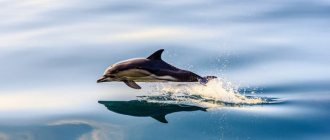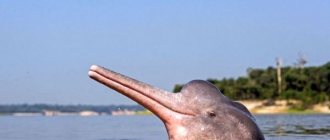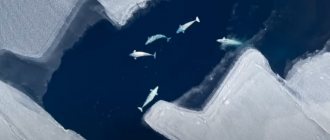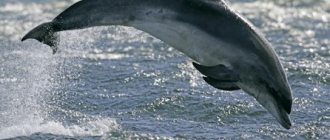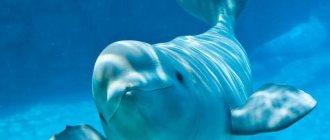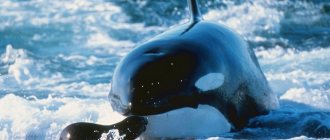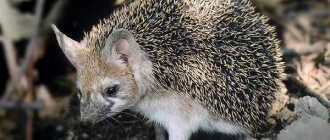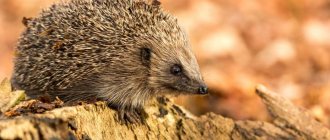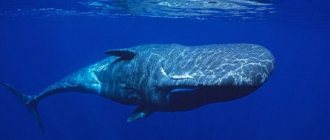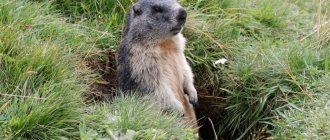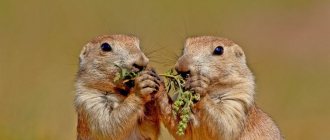- Wild animals
- >>
- Mammals
An elegant body, a smiling face, immense curiosity for humans and a cheerful disposition - yes, this is all a bottlenose dolphin . Dolphin, as many are accustomed to calling this intelligent mammal. He has the most good-neighbourly relations with the person. Today, there are already dolphinariums in every coastal city, where everyone can make their dream of swimming with dolphins come true at a reasonable price. But is the bottlenose dolphin so cute and harmless?
Origin of the species and description
Photo: Afalina
The topic of the origin of marine mammals is very intriguing. How did these animals end up living in the deep sea? It is not easy to answer this question, but there are several assumptions about the occurrence of this event. They all boil down to the fact that the ungulate ancestors, eating fish, spent more and more time in the water in search of food. Gradually their respiratory organs and body structure began to change. This is how ancient whales (Archaeocetes), baleen whales (Mystacocetes), and toothed whales (Odonocetes) appeared.
Modern sea dolphins are descended from a group of ancient toothed whales called Squalodontidae. They lived during the Oligocene period, but only in the next Miocene period, about 20 million years ago, did 4 families emerge from this group, which exist to this day. Among them were river and sea dolphins with their three subfamilies.
The species of bottlenose dolphin or bottlenose dolphin (Tursiops truncatus) comes from the genus Bottlenose dolphin (Tursiops), the family Delphinidae. These are large animals, 2.3-3 m long, some individuals reach 3.6 m, but quite rarely. The weight of bottlenose dolphins varies from 150 kg to 300. A characteristic feature of dolphins is a developed “beak” on a long, almost 60 cm, skull.
The thick fat layer of the dolphin's body provides it with thermal insulation, but these mammals do not have sweat glands. That is why the fins: dorsal, pectoral and caudal are responsible for the function of heat exchange with water. A beached dolphin's fins very quickly overheat and, if you don't help him by moisturizing them, they will simply stop working.
Links[edit]
- ^ abc Wells, R.; Scott, M. (2002). "Bottlenose dolphins." In Perrin, W.; Wursig, B.; Thewissen, J. (Ed.). Encyclopedia of Marine Mammals. Academic press. pp. 122–127. ISBN 978-0-12-551340-1.
- ^ abcde Wells, R.S.; Natoli, A.; Braulik, G. (2019). "Tursiops truncatus". IUCN Red List of Threatened Species
.
2019
: e.T22563A50377908. DOI: 10.2305/IUCN.UK.2019-1.RLTS.T22563A50377908.en. - ^ abc Wilson, Delaware; Reader, D.M., ed. (2005). "Tursiops truncatus". Mammal Species of the World: A Taxonomic and Geographical Guide (3rd ed.). Johns Hopkins University Press. ISBN 978-0-8018-8221-0. OCLC 62265494.
- ^ ab Leatherwood, S., & Reeves, R. (1990). Bottlenose dolphin
. San Diego: Academic Press, Inc., ISBN 0-12-440280-1 - ^ B s d e g h i JK Jenkins, J. (2009) Tursiops truncatus. Animal Diversity Network.
- ^ ab Anonymous (2002). "Bottlenose Dolphin". seaworld.org. Retrieved January 17, 2009.
- ^ ab Klinovskaya, M. (1991). Dolphins, porpoises and whales of the world: The IUCN Red List
. Gland, Switzerland, UK: IUCN, ISBN 2880329361 - ^ ab Newsletter of the American Cetacean Society - Bottlenose Dolphin, Archived July 25, 2008 at the Wayback Machine
- ^ abcde e Shirihai, H.; Jarrett, B. (2006). Whales, dolphins and other marine mammals of the world
. Princeton: Princeton Univ. Click. pp. 155–158. ISBN 978-0-691-12757-6. - Reeves, R.; Stewart, B.; Clapham, P.; Powell, J. (2002). The National Audubon Society's Guide to the World's Marine Mammals. New York: A. A. Knopf. pp. 362–365. ISBN 978-0-375-41141-0.
- » Tursiops truncatus, Bottlenose dolphin » . MarineBio.org
. Archived from the original on April 6, 2008. Retrieved September 16, 2014. - Wells, R. S. (2006). American Cetacean Society Fact Sheet: Bottlenose Dolphin (Tursiops truncatus). Archived April 25, 2013, at the Wayback Machine.
- Marino, Laurie; Connor, Richard S.; Fordyce, R. Ewen; Herman, Louis M.; Hof, Patrick R.; Lefebvre, Louis; Lusso, David; McCowan, Brenda; and others. (2007). "Cetaceans have complex brains for complex cognition". PLoS Biology
.
5
(5):e139. DOI: 10.1371/journal.pbio.0050139. PMC 1868071. PMID 17503965. - ↑
Reiss, Diana;
McCowan, Brenda (September 1993). "Spontaneous vocal mimicry and production by bottlenose dolphins ( Tursiops truncatus
): evidence for vocal learning".
J Comp Psychol
.
107
(3):301–12. DOI: 10.1037/0735-7036.107.3.301. PMID 8375147. - "Dolphin Institute - Behavioral Mimicry". Archived from the original on 2008-05-11. Retrieved August 31, 2008.
- Herman, L. (2002). "Language learning". In Perrin, W.; Wursig, B.; Thewissen, J. (Ed.). Encyclopedia of Marine Mammals. Academic press. pp. 685–689. ISBN 978-0-12-551340-1.
- "Dolphin Institute - Understanding Language". dolphin-institute.org
. Archived from the original on 2008-12-11. - "Intelligence and People". wiu.edu
. Retrieved August 11, 2008. - Marten, K.; Psarakos, S. (2006). "Evidence for self-awareness in bottlenose dolphins (Tursiops truncatus)". In Parker, ST; Mitchell, R.; Boccia, M. (ed.). Self-awareness in animals and humans: Developmental perspectives
. Cambridge University Press. pp. 361–379. ISBN 978-0521025911. Archived from the original on 2008-10-13. Retrieved October 4, 2008. - "American Cetacean Society - Bottlenose Dolphin". Archived from the original on 2008-07-25. Retrieved August 31, 2008.
- "U.S. Navy Marine Mammal Program Website". US Navy Marine Mammal Program. Archived from the original on 2009-01-15.
- "Dolphins deployed as underwater agents in Iraq". National Geographic. Retrieved January 18, 2009.
- "Bottlenose Dolphin". Archived from the original on 2008-04-21. Retrieved August 11, 2008.
- Venn-Watson, Stephanie; Baird, Mark; Novik, Brittany; Parry, Celeste; Jensen, Eric D. (2020). "A modified fish diet altered the serum metabolome and alleviated chronic anemia in bottlenose dolphins (Tursiops truncatus): potential role of odd-chain saturated fatty acids". PLoS ONE
.
15
(4): e0230769. DOI: 10.1371/journal.pone.0230769. - Ai, Whitlow (1993). Dolphin Sonar
. New York: Springer-Verlag. ISBN 978-0-387-97835-2. - "REGULAR DOLPHIN BOTTLE". animalia.com. Retrieved February 13, 2022.
- "Marine Mammals - Bottlenose Dolphin". oceana.org. Retrieved February 13, 2022.
- ^ ab "Bottlenose Dolphin (Tursiops truncatus) - Office of Protected Resources - NOAA Fisheries". Retrieved September 16, 2014.
- ↑
Hersh S.L., D.K. Odell, E.D.A. "Mortality patterns of bottlenose dolphins in the Indian/Banana River system of Florida" in The Bottlenose Dolphin (eds. Leatherwood, S. and Reeves, R.S.) 155–164 (New York: Academic Press, 1990). - Odell, D. C. Status and life history aspects of the bottlenose dolphin, Tursiops truncatus, in Florida. J. Fish. Res. Board Canada 32, 1055–1058 (1975).
- Stolen, MK & Barlow, J. TYPICAL LIFE TABLE OF BOTTLE DOLPHINS (TURSIOPS TRUNCATUS) FROM THE INDIAN RIVER LAGOON SYSTEM, FLORIDA, USA. Mar. Mammal Sci. 19, 630–649 (2003).
- Martien, K. K. et al. Population structure of island dolphins: evidence from mitochondrial and microsatellite markers for common bottlenose dolphins (Tursiops truncatus) around the main Hawaiian Islands. Mar. Mammal Sci. 28, E208–E232 (2012).
- JP de Magalhães et al., The Human Aging Genomic Resources: Online databases and tools for biogerontologists. Aging cell. 8 (2009), pp. 65–72.
- Scott, M., & Chivers, S. (1990). "Distribution and structure of the bottlenose dolphin stock in the eastern tropical Pacific", pp. 387–402 in S. Leatherwood and R. Reeves, The Bottlenose Dolphin
, San Diego: Academic Press, Inc., ISBN 0-12-440280-1 - "Bottlenose Dolphin". WWF
. Retrieved May 13, 2022. - Halpin, Luke R.; Towers, Jared R.; Ford, John KB (20 April 2018). "First record of the common bottlenose dolphin (Tursiops truncatus) in Canadian Pacific waters". Marine Biodiversity Records
.
11
: 3. DOI: 10.1186/s41200-018-0138-1. ISSN 1755-2672. - "Habitat and Distribution".
- "Frequently Asked Questions: Campaign to Save the Japanese Dolphins". International Marine Mammal Project. February 17, 2016. Retrieved November 29 +2016.
- Jump up
↑ Kenyon, P. (2004-11-08).
"Lunch with Dolphin Hunters". BBC News
. Retrieved September 30, 2008. - "Dolphin Institute - Threats to Bottlenose Dolphins and Other Marine Mammals". Archived from the original on 2008-12-09. Retrieved September 30, 2008.
- "Fungie wins title of longest-living friendly dolphin". independent.ie
. - "Appendix II" to the Convention on the Conservation of Migratory Species of Wild Animals
(CMS). As amended by the Conference of the Parties to the Bonn Convention in 1985, 1988, 1991, 1994, 1997, 1999, 2002, 2005, 2008, 2011 and 2014. Valid from February 8, 2015. - "Convention on Migratory Species, page on the common bottlenose dolphin". Retrieved September 16, 2014.
- "Pacific Cetaceans MoU". pacificcetaceans.org. Retrieved September 16, 2014.
- "MoU on Aquatic Mammals of West Africa". cms.int . Retrieved September 16, 2014.
- Rafe, John S.; Schaefer, Adam M.; Bossart, Gregory D.; Fair, Patricia A. (07/24/2017). “Project to assess the health and environmental risks of the bottlenose dolphin Tursiops truncatus from the southeastern United States. II. Environmental aspects". Diseases of aquatic organisms
.
125
(2):155–166. DOI: 10.3354/dao03143. ISSN 0177-5103. PMID 28737160. - “Ocean Pollution | National Oceanic and Atmospheric Administration". www.noaa.gov
. Retrieved March 18, 2022. - Lane, Suzanne M.; Smith, Cynthia R.; Mitchell, Jason; Bulmer, Brian C.; Barry, Kevin P.; McDonald, Trent; Mori, Chiharu S.; Rosel, Patricia E.; Rawls, Teresa K.; Speakman, Todd R.; Townsend, Forrest I.; Tumlin, Mandy S.; Wells, Randall S.; Zolman, Eric S.; Schwacke, Laurie H. (2015). "Reproductive outcome and survival of common bottlenose dolphins sampled in Barataria Bay, Louisiana, USA, following the Deepwater Horizonoil spill". Proceedings of the Royal Society B: Biological Sciences
.
282
(1818): 20151944. DOI: 10.1098/rspb.2015.1944. PMC 4650159. PMID 26538595. - Sigua, Gilbert S.; Steward, Joel S.; Twidale, Wendy A. (February 1, 2000). "Water Quality Monitoring and Biological Integrity Assessment in the Indian River Lagoon, Florida: Status, Trends, and Pressures (1988–1994)." Environmental Management
.
25
(2): 199–209. DOI: 10.1007/s002679910016. ISSN 0364-152X. PMID 10594193. - "Eutrophication | USGS.gov". www.usgs.gov
. Retrieved March 18, 2022. - Pierce, R.H.; Henry, M. S. (2008-10-01). "Harmful algal toxins from Florida red tide (Karenia brevis): natural chemical stressors in South Florida coastal ecosystems". Ecotoxicology
.
17
(7): 623–631. DOI: 10.1007/s10646-008-0241-x. ISSN 0963-9292. PMC 2683401. PMID 18758951. - "Ecological Effects of Harmful Algal Blooms on Fish and Wildlife Communities Associated with Submerged Aquatic Vegetation" (PDF).
Appearance and features
Photo: Bottlenose dolphin
The body color of bottlenose dolphins is deep brown on top, and much lighter below: from gray to almost white. The dorsal fin is high, widening significantly at the base, and has a crescent-shaped cutout at the back. The pectoral fins also have a wide base and then taper to a sharp tip. The anterior edges of the fins are thicker and convex, while the posterior edges, on the contrary, are thinner and concave. Black Sea bottlenose dolphins have some color features. They are even divided into two groups. The first is characterized by a clear line between the dark area of the back and the light belly, and near the dorsal fin they have a light triangle, with its apex directed towards the fin.
Another group does not have a clear boundary between the light area and the dark area. The coloring in this part of the body is blurred, has a smooth transition from dark to light, and there is no light triangle at the base of the dorsal fin. Sometimes the transition has a zigzag-shaped border. There are several subspecies of bottlenose dolphins; they are distinguished based on their habitat and some features of their body structure or coloring, as is the case with the Black Sea ones:
- Common bottlenose dolphin (Tttruncatus, 1821);
- Black Sea bottlenose dolphin (Ttponticus, 1940);
- Far Eastern bottlenose dolphin (Ttgilli, 1873).
Indian bottlenose dolphin (Ttaduncus) - some scientists consider it a separate species, since it has more pairs of teeth (28 instead of 19-24). The lower jaw of bottlenose dolphins is more elongated than the upper. There are a lot of teeth in a dolphin’s mouth: from 19 to 28 pairs. There are 2-3 pairs less of them on the lower jaw. Each tooth is a sharp cone, 6-10 mm thick. The arrangement of the teeth is also interesting; they are placed in such a way that there are free spaces between them. When the jaw closes, the lower teeth fill the upper gaps and vice versa.
The animal's heart beats on average 100 times per minute. However, with great physical exertion it gives all 140 blows, especially when developing maximum speed. The bottlenose dolphin's speed is at least 40 km/h, and they are also capable of jumping 5 m out of the water.
The bottlenose dolphin's vocal apparatus is another amazing phenomenon. Air sacs (3 pairs in total), interconnected by the nasal passages, allow these mammals to produce various sounds with a frequency of 7 to 20 kHz. In this way they can communicate with their relatives.
Conditional safety for the dolphin
However, these dolphins have long been objects of hunting. But now this has come to an end. Hunting for bottlenose dolphins was completely prohibited in the 60s of the last century; they already appear in the Red Book. Although poachers are still encountered occasionally, the authorities are ready to fully fight them.
But there is no need to fear for the existence of the Black Sea bottlenose dolphin. It is a mistake to believe that any animal listed on the “red” pages can become extinct at any moment. The “protective book” was created precisely to prevent this. She defines the status of this dolphin as “threatened.” The species is truly unsafe from the reduction of fish stocks and the intensification of shipping. But man does not consciously offend the sea smarties (unless by accident), and there are no natural threats to their existence.
And numerous dolphinariums have long mastered not only the organization of water shows, but also the process of increasing the “actor recruiting base.” The birth of offspring from floating artists has long been a common occurrence. And the injured dolphins often receive help, significantly increasing their chance of survival.
Where does the bottlenose dolphin live?
Photo: Black Sea bottlenose dolphin
Bottlenose dolphins are found in almost all warm waters of the world's oceans, as well as in temperate ones. In Atlantic waters they are distributed from the southern borders of Greenland to Uruguay and South Africa. In the local seas: the Black, Baltic, Caribbean and Mediterranean, dolphins are also found in abundance.
They cover the Indian Ocean starting from the northernmost, including the Red Sea, then their range extends south all the way to South Australia. Their population occupies the Pacific Ocean from Japan to Argentina, while capturing the state of Oregon all the way to Tasmania.
Other human interactions[edit]
Five dolphins jumping in a show
Dolphin sightings in the ocean south of Cape May, New Jersey.
Some interactions with humans are harmful to dolphins. The dolphin hunting industry exists in several countries including Japan, where common bottlenose dolphins are hunted for food annually in the city of Taijit, [38] and the Faroe Islands. Additionally, dolphins are sometimes killed carelessly as bycatch from tuna fishing. [39] [40]
Tiao was a well-known male bottlenose dolphin who was first spotted in the city of San Sebastian in Brazil around 1994 and often allowed people to interact with him. The dolphin later became famous for killing a swimmer and injuring many others, earning him the nickname of the killer dolphin.
Bronze statue of "Fungie" in Dingle, Ireland
Fungus is another solitary male bottlenose dolphin living in close contact with people in Dingle Harbour, Ireland, since 1983. He has become a symbol of the city, although there is some doubt that he is a lone dolphin. [41]
What does the bottlenose dolphin eat?
Photo: Bottlenose dolphins
Fish of various species constitute the main diet of bottlenose dolphins. They are excellent sea hunters and use different methods to catch their prey. After all, adult individuals must eat 8-15 kg of live food daily.
For example, dolphins hunt in a whole school for fish that lead a diurnal lifestyle:
- anchovy;
- mullet;
- anchovies;
- mullet;
- umbrina, etc.
If there is enough fish, bottlenose dolphins hunt only during the day. As soon as the size of the potential diet decreases, the animals begin to look for food closer to the seabed. At night, they change tactics.
Bottlenose dolphins gather in small groups to hunt other inhabitants of the deep sea:
- shrimp;
- sea urchins;
- electric stingrays;
- flounder;
- some types of sharks;
- octopuses;
- acne;
- shellfish
They lead an active lifestyle at night, and bottlenose dolphins have to adapt to their biorhythms in order to get enough. Dolphins are happy to help each other. They communicate and give special signals by whistling, preventing the prey from escaping and surround it from all sides. These intelligences also use their audio signals to confuse their victims.
What does it look like
An adult reaches 2 - 2.5 meters in length and can weigh from 130 to 200 kg. Larger dolphins of this species have also been recorded: off the coast of Great Britain, for example, an individual weighing 650 kg and whose body length was 3.8 meters was caught. There are 4 subspecies of bottlenose dolphins in the World Ocean: the Black Sea, Atlantic, North Pacific and Indian bottlenose dolphins. The differences between them are minor, mainly in some external features and structural features of the skull.
Features of character and lifestyle
Photo: Black Sea bottlenose dolphin
Bottlenose dolphins are sedentary; only sometimes you can find wandering flocks of these animals. Most often they choose coastal areas. It’s understandable where else they can get more food! Since the nature of their feeding is bottom-dwelling, they can dive very well. In the Black Sea they have to get food from a depth of up to 90 m, and in the Mediterranean these parameters increase to 150 m.
According to some data, in the Gulf of Guinea, bottlenose dolphins can dive to greater depths: up to 400-500 m. But this is the exception rather than the rule. But in the USA they conducted an experiment during which a dolphin began to dive to 300 m. This experiment was carried out as part of one of the Navy programs, and it took a lot of time to achieve results.
During the hunt, the dolphin moves in jerks, often making sharp turns. At the same time, he holds his breath for at least several minutes, and his maximum respiratory pause can be about a quarter of an hour. In captivity, a dolphin breathes differently; it needs to inhale 1 to 4 times per minute, while it first exhales, and then immediately takes a deep breath. While chasing prey, they whistle and even make something similar to a bark. When there is plenty of food, they signal to others that they are feeding by meowing loudly. If they want to scare one of their own, you can hear popping noises. To navigate the terrain or search for food, bottlenose dolphins use echolocation clicks, which are painfully reminiscent of the creaking of unlubricated door hinges.
Dolphins are active mainly during the day. At night, they sleep near the surface of the water, often opening their eyes slightly for a couple of seconds and closing them again for 30-40 seconds. They deliberately leave their tails hanging. Weak, unconscious blows of the fin on the water expose the body from the water to breathe. An inhabitant of the water element cannot afford to fall asleep soundly. And nature made sure that the hemispheres of the dolphin’s brain slept in turns! Dolphins are known for their love of fun. In captivity, they start games: one baby teases the other with a toy, and the latter catches up with him. And in the wild, they really love to ride the wave created by the bow of the ship.
Saving [edit]
In the North Sea, Baltic, Mediterranean and Black Sea populations of bottlenose dolphins are listed in Appendix II [42] to the Convention on the Conservation of Migratory Species of Wild Animals (CMS) of the Bonn Convention, as they have an unfavorable conservation status or would significantly benefit from international cooperation organized at based on individual agreements. [43]
Estimated population sizes for several specific areas include: [2]
| Square | Population |
| Northern Gulf of Mexico | 97 964 |
| East Coast of North America | 110 000 |
| Eastern tropical Pacific | 243 500 |
| Hawaiian Islands | 3 215 |
| California coast | 345 |
| Japan | 36 791 |
| East Sulu Sea | 2 628 |
| Western European continental shelf | 12 600 |
| Mediterranean Sea | less than 10,000 |
| Black Sea | at least several thousand |
This species is covered by the Agreement on Small Cetaceans of the Baltic, North-East Atlantic, Irish and North Seas (ASCOBANS), the Agreement on the Conservation of Cetaceans in the Black, Mediterranean and Adjacent Areas of the Atlantic (ACCOBAMS), the Memorandum of Understanding on the Conservation of Cetaceans and Their Habitats in the Pacific Region Islands [44] and the Memorandum of Understanding on the Conservation of Manatees and Small Cetaceans of West Africa and Macaronesia. [45]
Social structure and reproduction
Photo: Afalina
Dolphins have very developed social connections. They live in large flocks where everyone is related. They readily come to each other's rescue, and not only in pursuit of prey, but also in dangerous situations. It is not at all uncommon for a school of dolphins to kill a tiger shark that dared to attack a bottlenose dolphin calf. Dolphins also happen to save drowning people. But they do this not out of noble motives, but most likely by mistake, mistaking a person for a relative.
The ability of bottlenose dolphins to communicate has long excited scientists, so a lot of research has appeared in this direction. The conclusions from them were simply amazing. Bottlenose dolphins, like people, have character, and they can also be “good” and “bad”!
For example, the fun game of throwing a baby dolphin out of the water was not interpreted from the best side by the researchers. This is how adult bottlenose dolphins killed a baby from another pod. An examination of the cub who survived such “games” showed multiple fractures and severe bruises. Chasing a female during “mating games” sometimes looks depressing. The spectacle of warlike males looks more like violence. In addition to “sniffing” and adopting proud poses, they bite the female and squeal. The females themselves try to mate with several males at once, but not out of voluptuousness, but so that they all subsequently consider the born baby theirs and do not try to destroy it.
The breeding season for bottlenose dolphins occurs in spring and summer. The female becomes sexually mature when she reaches a size of more than 220 cm. After several weeks of rutting, pregnancy usually occurs for a period of 12 months. Pregnant females' movements slow down, and by the end of the term they become clumsy and unsociable. Childbirth lasts from a few minutes to a couple of hours. The fetus comes out tail first and the umbilical cord breaks easily. The newborn, pushed by the mother and 1-2 other females to the surface, takes its first breath in life. At this moment, a certain excitement covers literally the entire flock. The cub immediately seeks the nipple and feeds on its mother's milk every half hour.
The baby does not leave its mother for the first few weeks. Later he will do this without any obstacles. However, milk feeding will continue for about 20 months. Although dolphins can eat solid food as early as 3-6 months, as is the case in captivity. Puberty occurs at the age of 5-7 years.
Home >> Cetaceans >> Toothed whales >> Dolphins
family (Delphinidae)
|
|
Cetaceans of small size. Body length is 1.1-10 m (in the family one can distinguish small dolphins with a body length of 1.1-4 m, medium ones with a body length of 4.1-7 m and large ones with a body length of 7.1-10 m). Males are usually larger than females. Sexual dimorphism can also manifest itself in other characters - the shape and size of the dorsal fin, the shape of the pectoral fins. Caudal fin with a deep notch between the blades. Most representatives have a large dorsal fin (sometimes absent), located approximately in the middle of the body. The slit of the blowhole, located on the crown, is horseshoe-shaped and ends facing forward. There are no grooves on the throat. The “beak” is well developed, long or completely absent. The body color is varied: monochromatic (gray, black), dark above and light below, or with various light stripes or spots. The skull is asymmetrical. The zygomatic and temporal bones are poorly developed in the skull. The proximal parts of the facial bones do not form ridges. The pterygoid and nasal bones are relatively small in size. There are pre- and postorbital processes. The symphysis of the mandible usually does not exceed 1/3 of its length. Rostrum long or short. The width of the lower and upper jaws is approximately the same. Dental formula 0-65/2-58 The teeth are homodont, most dolphins are small in size, sometimes large and massive. The upper ones fit into the spaces between the lower ones. The cervical vertebrae are fused in various combinations. Distributed in almost all seas of the globe. Some are distributed very widely, almost all over the world (white-sided delphine, killer whales), others are more local. Mobile animals leading a gregarious lifestyle. The food is varied. Among the representatives of the family one can distinguish ichthyophages, teutophages, teutoichthyophages and sarcophagi.
All information is taken from books and the Internet.
Natural enemies of bottlenose dolphins
Photo: Bottlenose dolphin
Even such smart and large animals as dolphins cannot live in peace. Many dangers await them in the ocean. Moreover, these “dangers” are not always large predators! Young or weakened bottlenose dolphins are hunted by dogfish sharks, which themselves are quite small. Strictly speaking, large predators are a much greater danger. Tiger sharks and great white sharks can attack a bottlenose dolphin without a twinge of conscience, and with a high degree of probability they will emerge victorious from the fight. Although a dolphin has greater maneuverability and speed than a shark, sometimes mass still plays a dominant role.
A shark will never attack a school of mammals, because this practically guarantees the death of the predator. Dolphins, like no other sea creatures, can unite in a critical situation. Bottlenose dolphins can also face dangers at the very bottom. The stingray stingray with its spine is capable of repeatedly piercing a mammal, piercing its belly, lungs and thereby contributing to its death. The dolphin population suffers significant damage from natural disasters: sudden frosts or severe storms. But they suffer even more from humans. Directly - from poachers, and indirectly - from pollution of the world's oceans with waste and oil products.
Marine pollution[edit]
Common bottlenose dolphins are the most common apex predator found in coastal and estuarine ecosystems along the southern coast of the United States [46], thus serving as an important indicator of bioaccumulation and ecosystem health.
Some diseases commonly found in dolphins are believed to be related to human behavior, such as water pollution. Water pollution involves pollution from point and non-point sources. Point source pollution occurs from a single source, such as an oil spill [47] and/or the release of chemicals from a specific site. The environmental impacts of the Deepwater Horizon oil spill caused immediate impacts and still serve as long-term impacts on the population into the future. Common bottlenose dolphins use these important habitats for calving, foraging, and foraging. Environmental exposure or changes from chemicals or marine pollution can alter and disrupt endocrine systems, affecting future populations. For example, oil spills have been linked to pulmonary and reproductive diseases in female dolphins. A recent study [48] showed signs of lung disease and reduced stress in 32 dolphins that were captured and studied in Barataria Bay, Louisiana, USA. Of these 32 dolphins, 10 were found pregnant, and after a 47-month survey, only 20% had given birth to viable calves, compared to 83% previously in the same area. A recent oil spill in the area is believed to be partly to blame for the low numbers.
Dense human development along Florida's east coast and intensive agricultural activity have led to increased freshwater resources, changes in drainage systems, and altered water quality (i.e., chemical pollution, high nutrient input, decreased salinity, decreased seagrass habitat, and eutrophication. [ 49] High nutrient inputs from agricultural chemicals and fertilizers cause eutrophication[50] and hypoxia, causing severe declines in water quality. Excess phosphorus and nitrogen from these non-point sources deplete the natural oxygen cycle due to excessive consumption of algae. Harmful algal blooms cause dead zones and unusual deaths of common bottlenose dolphins consuming these toxic fish due to brevetoxin produced by the dinoflagellate Karenia brevis
. [51] Brevetoxins are neurotoxins that can cause acute respiratory and neurological symptoms, including death, in marine mammals, sea turtles, birds and fish. [52]
